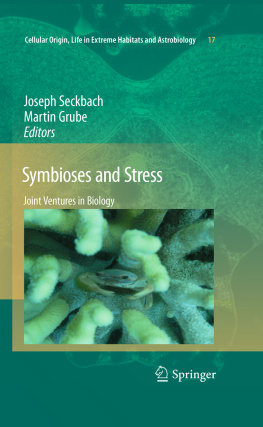Parasitism, mutualism, lichenism etc., are each special cases of that one general association for which the term symbiosis is proposed as the collective name.
Anton de Bary (1878, pp. 2122)
The double danger of research into this type of phenomenon lies, on the one hand, in bringing to them preconceived ideas of too subjective a nature, bordering on an illusory anthropomorphism, and on the other hand, trying to reduce complex facts to simple elementary reactions.
Maurice Caullery (, p. 2)
The Genesis of the Word
The concept of symbiosis took root in evidence that lichens were dual organisms, comprised of fungi and algae (Sapp, ).
Schwendener perceived of the lichen relationship in terms of fungal master and algal slave, but others saw the relationship to be more a matter of cooperative living. The alga (autotrophic) synthesizes carbohydrates and borrows from the fungus (heterotrophic) the nitrogenous and albuminoid material that the latter builds up with the help of the carbohydrates furnished by the alga; besides this, the fungus draws up water and mineral substances. Johannes Reinke ().
Still, the term symbiosis was not attributed to Frank, but rather to Anton de Bary at the University of Strasbourg. He first used it in an address on The Phenomena of Symbiosis delivered at a conference of the Association of German Naturalists and Physicians at Kassel in 1878. Like Frank, de Bary () to describe relationships in the animal kingdom, which, he said, were as varied as those found in human societies. He classified them in terms of parasitism, commensalism and mutualism.
1.1 The Parasite
Is he whose profession it is to live at the expense of his neighbour, and whose only employment consists in taking advantage of him, but prudently, so as not to endanger his life (van Beneden, , p. 85).
1.2 The Commensal Or Messmate
Is he who is received at the table of his neighbour to partake with him of the produce of his days fishing. The messmate does not live at the expense of his host; all that he desires is a home or his friends superfluities (van Beneden, , p. 1). Van Beneden was thinking, for example, of pilot fish swimming alongside sharks from whom they receive aid and protection.
1.3 The Mutualists
Are animals which live on each other, without being either parasites or messmates; many of them are towed along by others; some render each other mutual services, others again take advantage of some assistance which their companions can give them; some afford each other an asylum, and some are found which have sympathetic bonds which always draw them together. (van Beneden, , p. 68)
Many insects while sheltering in the fur of mammals for example, cared for the toilet of their host by feeding on epidermal debris and excretions. Some mutualists, such as the Egyptian plover that keeps the teeth of the crocodile clean, rendered services that van Beneden (, p. 107) compared to medical attendance.
De Bary argued that commensals in the sense of van Beneden could not be found in the plant kingdom, but relationships approaching mutualists could be found there. He described the intimate association of blue-green algae, Anabaena, and a genus of aquatic ferns, Azolla, that float on the surface of freshwater ponds and marshes. The algae live inside special sealed cavities of the leaves. He suspected that the host protected the algae, but he had no idea of a reciprocal service they rendered in return (de Bary, , p. 21). He noted blue-green algae that produced nodules inside the cells of the roots of the palm-like cycads in which they lived. Finally, he pointed to lichens which he himself had long studied: there were thousands of species, and all were constituted by the association of fungi and algae. In his view, the relationship between fungi and algae could be one of parasitism or of mutualism depending on the species involved in the lichen in question.
The most significant aspect of symbiosis, as de Bary saw it, was that it could lead to morphological variations that were not pathological. So he came to his central thesis: that symbiosis was a means for generating evolutionary novelty that could be investigated experimentally. It was a mode of evolutionary innovation in addition to gradual evolution based on the accumulation of individual variations within populations of species. Whatever importance one wants to attach to natural selection for the gradual transformation of species, it is desirable to see yet another field opening itself up to experimentation. This is why I wanted to call your attention to these here, though they can only shed light on a part of the phenomena (de Bary, , pp. 2930).
Symbiosis as Division of Labour
During the 1880s, several other microbeplant relationships were added to those deemed symbiotic (Sapp, ) suggested otherwise for the mycorrhiza and distinguished between ectotrophic mycorrhiza that remain external to roots, and endotrophic mycorrhiza that penetrate into the cells of the root. Far from being parasites, ectotrophic fungi functioned as root hairs: bringing minerals and nitrogenous food to the plant, which for its part, yielded carbohydrates to the fungus. The endotrophic fungus would be digested by the plant and thus providing it with nitrogen. It seemed to him that endotrophic fungi benefited trees without receiving anything in return, and he suggested that plants somehow attracted the fungi.
Some of the most widely discussed theories emerged from studies of animal chlorophyll in sponges, protozoa to worms and sea-anemones, the so-called plant-animals: the phytozoa. The main interest in these chlorophyll-containing organisms lay in their bearing on the long-disputed taxonomic relations between plants and animals (Sapp, ). The alga and host relationship was understood as one of mutual dependence: The translucent animal cell provided CO2 and nitrogen for the symbiont, which in turn provided its host with oxygen and starch.
Algae living in the animal cell came to be seen as a microcosm for a view of the relations of plant and animal worlds as a whole functioning as an integrated superorganism (Spencer, , p. 19), first director of the Marine Biological Laboratory in Woods Hole, stated:
On the same grounds that the sociologist affirms that a society is an organism, the biologist declares that an organism is a society.
A society is an organized whole, the unity of which consists in, and is measured by, the mutual dependence of its members. The living body is an organization of individual cells with the same bond of unity. The principle of organization in both cases is the division of labor or function.








